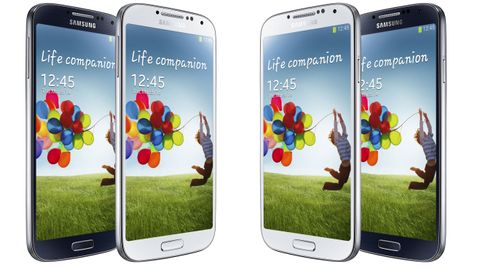Why you can trust TechRadar
At the time of its release, the Samsung Galaxy S4 came with what I felt was the best display you could find on a smartphone. While it's since been superseded by the likes of the HTC One M9 and the Samsung Galaxy S6, it still holds up to scrutiny today.
It's the same Super AMOLED technology used in other Galaxy smartphones, but it was the first in the range to be cranked up to Full HD resolution (1920 x 1080 pixels if you're asking), meaning a still-sharp 441ppi. This year's S6 has a 1440 x 2560 pixel resolution (577ppi).
The S4's screen uses the same PenTile matrix that's drawn so much criticism over the years, as some state that Samsung is using too many of one colour of pixel, or that the sub-pixel (the colours within each pixel) arrangement is too basic. All of this has meant that older Galaxy smartphones have had something of a blue or green tint, or been a little low-resolution when viewed (admittedly very) close up.
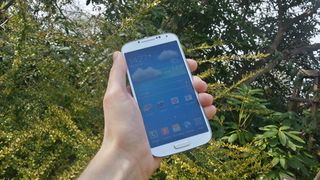
Well, and you'll forgive me for saying the same thing that I did with the Galaxy S3, close up now there's no way you can see any jagged edges or elements within the icons. It's simply superb, and makes everything from web pages to video look brilliant.
There's no worry about the tints of old, nor the criticisms levied at Samsung for making over-saturated screens, as often people have claimed that the colours look too strong on these devices thanks to the OLED technology used.
It is a feature of the technology, and not just because of the high contrast ratios on offer, but with the Galaxy S4 Samsung added in a mode to make the colours look more natural, should the user so wish to have it that way.
This method does drop the brightness somewhat, and that's already lower than you might find on the HTC One, but that extra brightness isn't needed thanks to the contrast ratio I mentioned earlier.

One of the strengths of OLED technology is that when a pixel is displaying a black image, it's completely off, and therefore draws less power and looks darker. Compared to LCD screens, which have a backlight to light the colours in front, this means that the blacks will never be as black as found on an OLED.
So, as I said, there's nothing to want for with the Super AMOLED Full HD screen found on the Samsung Galaxy S4. It might not be as high resolution as the phones we saw at MWC 2015 - it's been out for two years after all - but viewed up close you'll struggle to find a flaw with it.
You can change the brightness from the notification bar, accessed by sliding your finger down from the top of the screen, but if you want to make things easier you can just tag the auto button here and have the Galaxy S4 work away at deciding the optimum brightness for you.
You can also customise the auto level - so if you like things a little lighter or darker, then you can choose such a thing. It's a good way to manage your battery even easier.
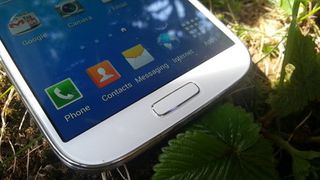
Another display feature is the improved capacitive technology used in the screen. This is designed to ape a feature introduced by Nokia on the Lumia 920, which enables you to wear gloves and still use the phone - which will be a key feature to those in colder climes, or who like to wear gloves for sport or similar.
There used to be an issue whereby this feature rendered the screen a little too sensitive and twitchy to the gloved touch, but having used the phone after the Android 4.4 update, it doesn't appear to be such an issue. Naturally, I'll let you know if extended use reveals otherwise.
All of which means there's not a thing that I can criticise the Samsung Galaxy S4 screen for in any way, as it's still close to perfect for a smartphone - making it a great device for so many more functions as a result.
The latest batch of handsets on the market are starting to up smartphone screen resolutions to QHD standards, but the jury is out on whether this is wholly necessary, or whether the benefits outweigh the inevitable hit to battery life.
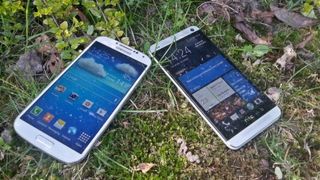
Until that's answered the Samsung Galaxy S4's screen will continue to be one of my favourites - particularly for the price.
Over recent years, Samsung has increasingly turned to software gimmicks in order to differentiate its smartphones from the crowd. It could be argued that this really started to get silly with the Samsung Galaxy S3, and looking at the Galaxy S4 afresh today confirms that Samsung tried to pack way too much in here.
There are tons of gimmicks, like Smart Stay. This isn't a new feature for the Galaxy S4, but it's a better implementation than we saw on the Galaxy S3. Back then the result was a little patchy, and also contributed to some dodgy auto-brightness levels.
In case you don't know, Smart Stay is another of Samsung's eye-tracking technologies, one that can tell when you're looking at the screen and won't dim or put it into sleep mode as a result.
This time around it's nearly flawless at checking out when your eyes are looking at the screen, although when it does get it wrong and things begin to dim there's no way to save it (despite us blinking and flashing our eyes at the display in the vain hope the S4 might recognise the effort).
Of course, you could just tap the screen with your finger - but come on, this isn't 2011.
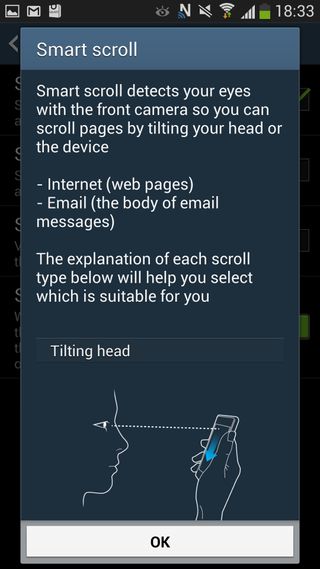
Then there's Smart Scroll. This technology was designed to also monitor your eyes, but when it notes you're looking at the phone the Galaxy S4 will enable you to tilt the handset back and forth to move the text or email you're trying to read up and down the screen.
Well, this is what Samsung said at the Galaxy S4 launch, but it turns out that there's another, cooler, trick at work here: you can hold the phone steady and tilt your head up and down to achieve the same thing.
You have to make a pretty strong movement with your head to make this function work, but when it does it's pretty cool indeed and one of the 'down the pub' moments that will make people sit up and take notice.
However, and this is a big one: because the feature isn't perfect, I can't say it's a useful way to navigate around the screen. Using your finger remains a more useful way of scrolling around a screen.
Air View, meanwhile, allows you to hover your finger over certain items to see inside without opening.
Samsung has imbued a number of applications with this functionality, but in truth only a few really need it. For instance, being able to see which speed dials are assigned to which number is really useful, as otherwise you'd just have to press and find out.
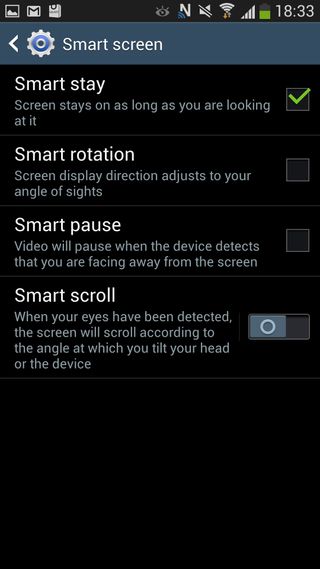
Less useful are things like video scrolling, where you can flick through the video using the timeline bar without having to disturb the main action. While this is a useful feature, there's not a lot of point to having to hover the finger over the screen to achieve it when you can just slide your finger on the screen, which is a much easier way of doing things.
Where Air View was somewhat useful, Air Gestures is possibly the least practical things on the phone. It's designed to let you simply wipe your hand over the front of the phone without touching it and means you can skip tracks, move between photos and answer calls without touching the phone.
I'll say that the latter functionality is good, but only when you're in a hands free situation, such as the car. There you don't want to be having to root around for the 'Call accept' function when you're supposed to have two hands on the wheel, where a simple wipe to answer is really cool.
I've got nothing against the option of doing things this way, and it's got a lot more accurate with the new software update. This means that there's no more (well, far fewer) missed gestures, and it won't activate when you don't want it to, which is another real bugbear I found at the start.

Other uses, such as moving between tabs in the internet browser and moving app icons around, are cool and could be useful in very niche situations... but it's still not really better than just touching the screen and doing it without worry.
There are some more instances where it's really, really useful – you can wipe over the screen and flick through PDF pages, scroll through web pages a large jump at a time or flip between tabs.
It's a clever system, but like I said, it's not useful enough – it's cool to do, but takes a little more effort than it should to be a natural flowing part of your phone use.
Like so many new features on the Galaxy S4, a little annoyance means you'll turn them off, and it's unlikely you'll ever turn them on again, which makes me feel bad for all those engineers that were asked to come up with all this innovation.
Perhaps the fact that they never felt right is the reason why Samsung has started to pare down some of its software extravagances on the Galaxy S5, Galaxy S6 and Galaxy S6 Edge.
Samsung made a big deal about S Health with the launch of the Galaxy S4, and it's clear to see the intent: it wanted to get a slice of the lucrative fitness market, and wanted to leverage the technology contained within the smartphone already.
It's a novel idea to have it so entrenched within the phone itself, but it does have some good ideas on how to use your phone to improve one's fitness. For instance, once you've entered all your weight, height and exercise details, the phone can tell you an idea weight to aim for, and how many calories per day you should ingest to achieve it.
On top of that, you get a guide to exercise levels each day, in a way that mimics Nike's FuelBand, which uses points to tell you how to get more active.
The S Health app can also now sync up with a Galaxy Gear smartwatch, and it'll even figure out when you've duplicated recorded steps and discard one of the data sets (the lowest one, thankfully). You'll have to download the Gear Manager app for this, though.
While I like the sentiment behind the S Health app, and the fact it works so much better than other similar apps, there's still a lot to wonder about in there.
You'll be set a 'steps per day' goal, whether walking or running. While on the days I took the Galaxy S4 running it had a larger uptick in the percentage of running steps, it was far from accurate.
Even on sedentary days, the S4 was congratulating me on running for a portion of it. Seems a bit unfair to all those people that were out sweating and pounding the streets, but I took the kudos.
Perhaps I'm being a little hard on this app, as it works well - just too simplistically. You can track your weight here nicely (and even more effectively if you purchase Samsung's Bluetooth scales) enter the food you've eaten to keep an eye on calories, and if you're organised enough, track all your exercise in one place.
But there's so much more to be done; what if you had running app capabilities within S Health, so it can monitor your runs in a similar way to Nike+, Adidas MiCoach or Endomondo? Samsung is missing a trick here - plus it needs to make the pedometer more accurate.
Despite several updates, S Health is still struggling to gain traction - and of course now it has much stiffer competition in the form of Apple Health and Google Fit. Still, Samsung looks determined to make it work, and the app is still present on its newest handsets, despite a lot of other bloatware getting the chop.

Gareth has been part of the consumer technology world in a career spanning three decades. He started life as a staff writer on the fledgling TechRadar, and has grown with the site (primarily as phones, tablets and wearables editor) until becoming Global Editor in Chief in 2018. Gareth has written over 4,000 articles for TechRadar, has contributed expert insight to a number of other publications, chaired panels on zeitgeist technologies, presented at the Gadget Show Live as well as representing the brand on TV and radio for multiple channels including Sky, BBC, ITV and Al-Jazeera. Passionate about fitness, he can bore anyone rigid about stress management, sleep tracking, heart rate variance as well as bemoaning something about the latest iPhone, Galaxy or OLED TV.
